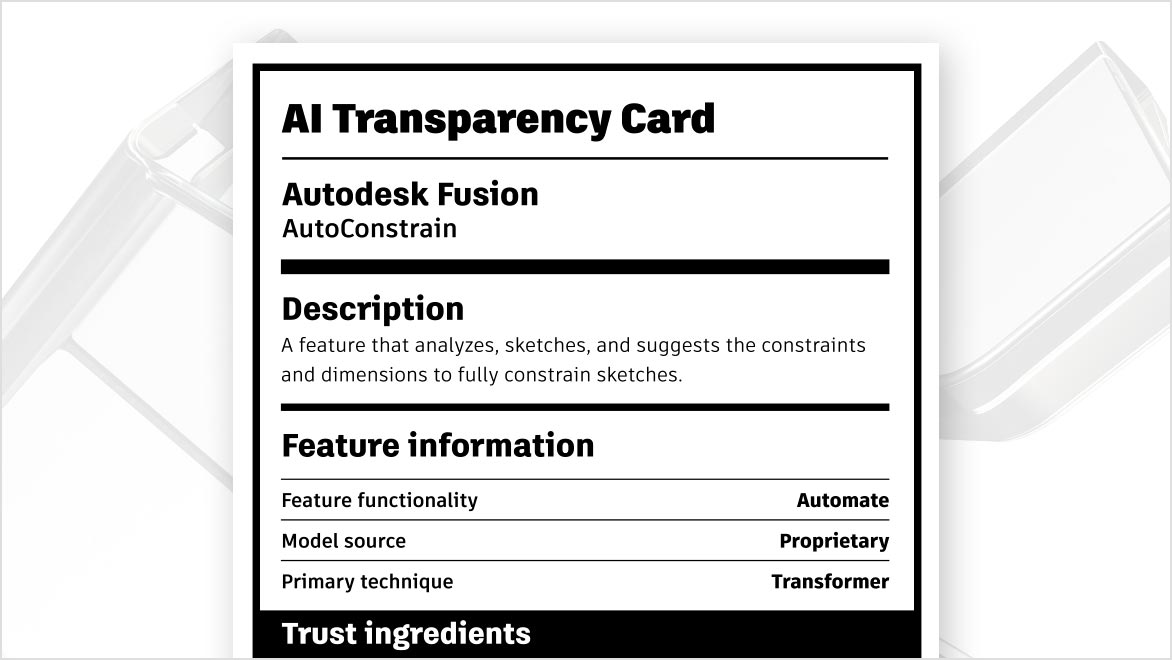& Construction

Integrated BIM tools, including Revit, AutoCAD, and Civil 3D
& Manufacturing

Professional CAD/CAM tools built on Inventor and AutoCAD
Autodesk is committed to responsible, ethical, and secure AI development, deployment, and use. We adhere to strict governance processes to protect our customers’ personal data and intellectual property. We implement responsible testing and monitoring practices throughout the AI lifecycle to mitigate or avoid instances where our AI might perpetuate biases, amplify social challenges, or lead to new avenues of risk.
We adhere to high standards in acquiring and managing data, and in training and delivering fair and safe AI models.
We are forthcoming about the design, development, and intended use of AI systems and data.
We respect our customers’ choices and align to laws and regulations.
We are rigorous in building AI systems that strive to provide accuracy, validity, and consistency.
We are committed to protecting data, intellectual property, and privacy, and producing safe outcomes.
The objective of Autodesk's AI policies and governance is to deliver value and minimize risk to privacy and intellectual property. This e-book details the rigorous standards and practices Autodesk employs to develop trusted AI within our products.
As part of our ongoing commitment to delivering trusted AI, we have developed AI transparency cards to disclose information about the AI features used in our products. These cards provide details on feature functionality, data sources, and the privacy and security safeguards in place.
Autodesk has voluntarily committed to the EU AI Pact, which encourages and supports organizations to plan ahead for the implementation of AI Act measures across the EU.
Autodesk’s Trusted AI program is responsible for our Trusted AI principles and practices, as well as our collaboration with government and industry groups working toward responsible AI.
Autodesk’s Trust Organization, led by the Chief Trust Officer, implements and continuously reviews guidelines and processes to evaluate and mitigate AI risks. We regularly assess industry practices, standards, and emerging trends to foster responsible AI development and use in alignment with global AI, intellectual property, data protection, and privacy laws and regulations.
Autodesk is collaborating with the National Institute of Standards and Technology (NIST) in the Artificial Intelligence Safety Institute Consortium to develop science-based and empirically backed guidelines and standards for AI measurement and policy, laying the foundation for AI safety across the world.
Autodesk is an active member of the Content Authenticity Initiative (CAI), which works to create a secure system for digital content provenance and media transparency. The work we do within CAI is fully compliant with the technical specifications released in 2022 by the Coalition for Content Provenance and Authenticity (C2PA) or C2PA Content Credentials.
Browse answers to your questions or contact an agent for assistance.
Reduce your risks of malware exposure and software failure by using genuine Autodesk software built by Autodesk.
Are you experiencing an outage with an Autodesk product or service? Check the real-time status of your cloud services.
Help us improve product security by reporting remote code execution, authentication bypass, or other vulnerabilities.





